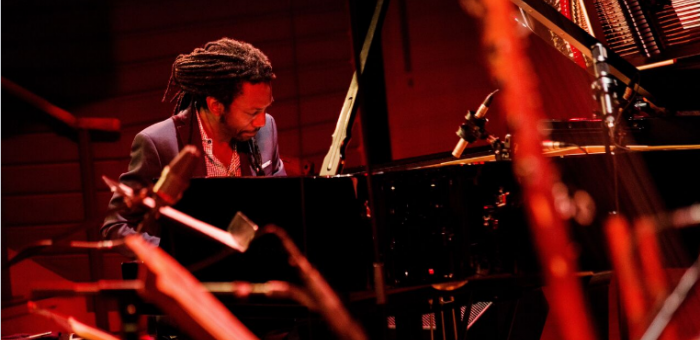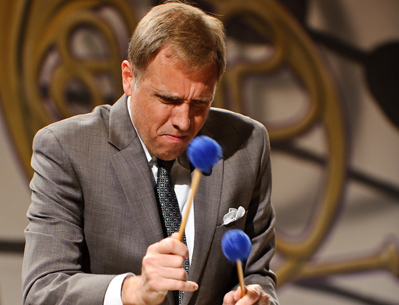Dec 9, 2025 12:28 PM
In Memoriam: Gordon Goodwin, 1954–2025
Gordon Goodwin, an award-winning saxophonist, pianist, bandleader, composer and arranger, died Dec. 8 in Los Angeles.…

Elio Villafranca performs Letters To Mother Africa at Jazz at Lincoln Center in New York.
(Photo: Lawrence Summulong)On a night as beautiful as the one in New York City on Oct. 15, it was appropriate that pianist Elio Villafranca would invoke the celestial bodies.
“Have you seen the moon?” he asked the audience at Jazz at Lincoln Center’s Appel Room, referring to the full, glowing sphere just out of sight beyond the venue’s enormous windows. He went on to presage the possibility that, under the full moon, unpredictable things were likely to happen.
“Hopefully, there will be no transformations tonight,” he said. Then, introducing his band—Billy Harper and David Murray on saxophones, Dezron Douglas on bass, Lewis Nash on drums and Abdou Mboup on percussion—he changed his mind: “Actually, we’re going to transform you.”
Transformation—of the personal, musical and cultural sort—was a constant, if not always explicit, theme of the program, which was titled Letters To Mother Africa and which dealt with the continuous influence of Africa’s culture on American and Caribbean jazz.
As an embodiment of such musical cross-pollination, there are few better authorities than Villafranca. Born in Cuba of African descent, the pianist, who arrived in the United States in 1995, has carved a reputation for himself as a leading authority on Afro-Caribbean musical history, not just in the performance sphere but in the educational sector as well.
Aside from numerous musical collaborations—his work on the 2010 album Things I Wanted To Do by Chembo Corniel earned him a Grammy nomination for Latin Jazz Album of the Year—Villafranca is also resident professor at Temple University in Philadelphia.
His set at the Appel Room provided listeners with an education of sorts, spanning generations of music, covering miles of global territory and encompassing numerous styles.
The ambitious program, grand in scale, unfolded in sections. It began with a cluster of Wayne Shorter’s “Angola,” the 1926 composition “King Of The Zulus,” Shorter’s “Africaine” (from his days in Art Blakey & The Jazz Messengers) and Harper’s own “Somalia.” In Villafranca’s hands, each tune underwent a thorough genetic unzipping.
The effect, at times, was startling. Into “Angola,” for example, the pianist injected rippling Afro-Latin rhythms that gave bracing authority to the song’s swing-generated melody. Into “King Of The Zulus,” the band introduced a time-stretching hemiola feel, framing the song’s swampy, New Orleans shuffle in the lens of modern jazz.
Other influences, not specifically African, were alluded to as well. In Harper and Murray, for example, there could be found the distinct traces of John Coltrane and Coleman Hawkins. Harper, especially, evoked Trane’s surging dynamism, emitting sweltering lines during his numerous solos, while Murray struck a balance between the sweet business of Hawkins and the effusive rabble-rousing of the avant-gardists, most notably on set-closer “Zimbabwe.”
Villafranca’s solos were equally varied in their stylistic influence. As a child, he studied Cuban percussion, and that early preparation has left its mark. He is a highly percussive pianist, with remarkably independent hands that work beautifully in tandem but can do wonders in counterpoint.
During the group’s take on “Africaine,” the pianist created a stormy ostinato with his left hand, slowly increasing the pressure upon it until piercing it with a sharply soaring melody from his right. It was musical tension-and-release at its best, and a testament to Villafranca’s keen storytelling skills.
Curation was obviously another one of Villafranca’s talents, and in his selection of tunes for this set the pianist revealed a deep and inclusive understanding of jazz and African music. Within the program’s historical rubric, Freddie Hubbard’s Afro-Cuban “Cunga Black” was able to rub melodic shoulders with Randy Weston’s impressionistic “African Lady,” and the trumpet style of Lee Morgan could be thematically linked to traditional Somalian music. Villafranca deserves credit for making those connections, and for creating such an illuminating through-line between the developments of multiple musical cultures.
There were other delights in Letters To Mother Africa, as Villafranca seemed to revel in the art of surprise. During the group’s haunting cover of Duke Ellington’s “Afrique,” for example, the pianist brought out guest vocalist Vuyo Sotashe, a South African with a wool-lined baritone who stunned the crowd with his lyrical precision. Sotashe’s sonic proximity to Nat “King” Cole was undeniable, and judging from the volume of the applause he received from the audience, one can expect to hear more from this young artist in the future.
Poet Aisha Jordan was another unannounced guest, though she proved a much-needed presence on Villafranca’s original composition “Nefertiti.” With clear, beseeching diction, she added probing poltical insight to the song’s stirring balladry.
But the highlight of the evening belonged to Senegalese percussionist Mboup, whose original composition “Nobnala” drew the most striking connection between jazz and Africa.
Though he had been enhancing the band’s sonic fabric through a variety of percussion instruments throughout the evening, for “Nobnala,” he settled on the kora, an African stringed instrument adorned with cymbals and bells. After a sweeping solo introduction, he engaged in a quiet yet impassioned duet with Villafranca, as the musicians attempted to intertwine their sounds, mirroring each other’s musical movements in real time.
It would be heard to deny the genuine connection shared between Villafranca and Mboup in that moment. These two gifted players gracefully illustrated the ways in which Mboup’s traditional African idioms seemed so naturally to embrace Villafranca’s jazz language.
Together, these musicians made it clear that the music of Africa, America and Cuba—though separated by miles of ocean—could be explored with penetrating closeness under the same moon.

Goodwin was one of the most acclaimed, successful and influential jazz musicians of his generation.
Dec 9, 2025 12:28 PM
Gordon Goodwin, an award-winning saxophonist, pianist, bandleader, composer and arranger, died Dec. 8 in Los Angeles.…

Belá Fleck during an interview with Fredrika Whitfield on CNN.
Jan 13, 2026 2:09 PM
The fallout from the renaming of the John F. Kennedy Center for the Performing Arts to include President Donald…

Flea has returned to his first instrument — the trumpet — and assembled a dream band of jazz musicians to record a new album.
Dec 2, 2025 2:01 AM
After a nearly five-decade career as one of his generation’s defining rock bassists, Flea has returned to his first…

Dec 11, 2025 11:00 AM
DownBeat presents a complete list of the 4-, 4½- and 5-star albums from 2025 in one convenient package. It’s a great…

Vibraphonist Chuck Redd found himself in the midst of a political firestorm after canceling his gig Dec. 24 at the newly renamed Trump Kennedy Center.
Jan 6, 2026 2:32 AM
The Board of Trustees at Washington, D.C.’s Kennedy Center for the Performing Arts voted on Dec. 18 to rename the…